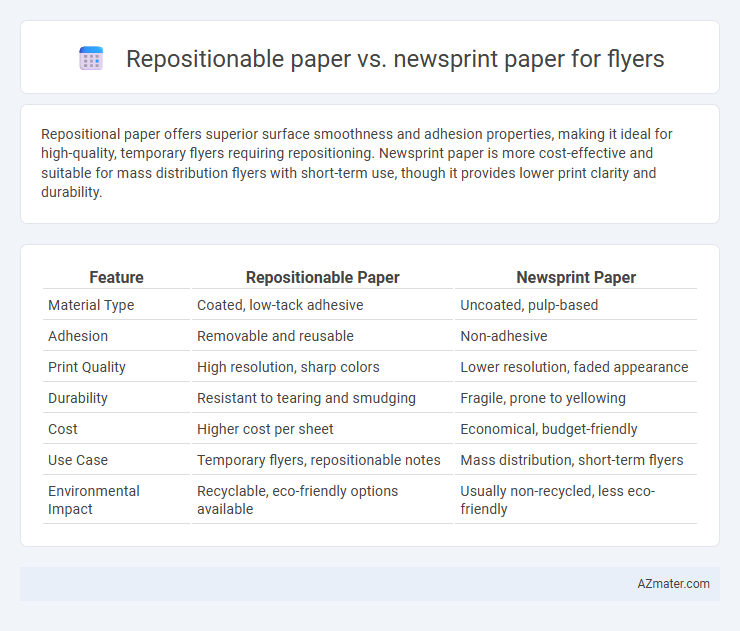Repositional paper offers superior surface smoothness and adhesion properties, making it ideal for high-quality, temporary flyers requiring repositioning. Newsprint paper is more cost-effective and suitable for mass distribution flyers with short-term use, though it provides lower print clarity and durability.
Table of Comparison
| Feature | Repositionable Paper | Newsprint Paper |
|---|---|---|
| Material Type | Coated, low-tack adhesive | Uncoated, pulp-based |
| Adhesion | Removable and reusable | Non-adhesive |
| Print Quality | High resolution, sharp colors | Lower resolution, faded appearance |
| Durability | Resistant to tearing and smudging | Fragile, prone to yellowing |
| Cost | Higher cost per sheet | Economical, budget-friendly |
| Use Case | Temporary flyers, repositionable notes | Mass distribution, short-term flyers |
| Environmental Impact | Recyclable, eco-friendly options available | Usually non-recycled, less eco-friendly |
Introduction to Flyer Paper Options
Flyer paper options primarily include Repositional paper and Newsprint paper, each catering to different printing needs and audience engagement. Repositional paper offers a smooth finish ideal for high-quality, vibrant graphics and allows for easy repositioning without residue, making it suitable for short-term marketing campaigns. Newsprint paper is cost-effective and lightweight, perfect for mass distribution with a more traditional, matte finish that absorbs ink quickly, ideal for economical bulk flyers.
What is Repositional Paper?
Repositional paper is a type of coated paper designed for temporary adhesion, allowing flyers to be easily attached, removed, and repositioned without leaving residue, making it ideal for short-term promotional materials. Unlike traditional newsprint paper, which is uncoated, lightweight, and highly absorbent, repositional paper offers a smoother surface for vibrant ink reproduction and enhanced print clarity. This paper's unique adhesive backing enhances flyer usability in dynamic marketing environments, where flexibility and reusability are essential.
Understanding Newsprint Paper
Newsprint paper is a lightweight, low-cost paper commonly used for newspapers and flyers due to its high absorbency and ease of printing. Compared to repositionable paper, newsprint offers lower durability and limited ink retention but provides excellent cost efficiency for short-term promotional materials. Its porous texture makes it ideal for mass distribution where vibrant colors and long-term handling are not priorities.
Key Differences: Repositional vs Newsprint Paper
Repositional paper features a repositionable adhesive backing that allows flyers to be easily applied, removed, and repositioned without leaving residue, ideal for temporary promotions or interactive marketing materials. Newsprint paper is an inexpensive, lightweight, and absorbent paper commonly used for mass distribution but offers lower print quality and durability compared to repositional paper. Key differences include adhesiveness, print quality, and cost-effectiveness, with repositional paper suited for reusable applications while newsprint serves high-volume, disposable flyers.
Durability and Longevity
Repositional paper offers moderate durability with its temporary adhesive, making flyers easy to reposition without damage, but it may degrade faster under frequent handling and exposure to moisture. Newsprint paper, though more economical, lacks durability and longevity as it is highly absorbent and prone to yellowing and tearing over time, especially in high-traffic flyer distribution. Choosing repositional paper enhances flyer lifespan and presentation quality, whereas newsprint suits short-term, mass-distribution purposes where cost is prioritized over durability.
Print Quality and Color Vibrancy
Repositional paper offers exceptional print quality with sharp, clear images and text, making it ideal for high-detail flyers, while newsprint paper tends to display coarser texture and less precise printing. Color vibrancy on repositional paper is superior due to its smoother surface and better ink absorption, resulting in vivid and saturated hues, whereas newsprint's porous nature often causes colors to appear dull or muted. For flyers requiring eye-catching visuals and professional appearance, repositional paper provides a significant advantage over standard newsprint.
Environmental Impact and Sustainability
Repositionable paper typically contains synthetic adhesives and plastic coatings that hinder biodegradability and recycling processes, contributing to greater environmental pollution compared to newsprint paper. Newsprint paper, derived from wood pulp with fewer chemical treatments, offers better recyclability and lower carbon emissions throughout its lifecycle, making it a more sustainable choice for flyer production. Choosing newsprint supports reduced landfill waste and promotes circular economy principles in printed materials.
Cost Comparison
Repositional paper generally has a higher cost compared to newsprint paper due to its specialized adhesive properties that allow for easy repositioning without residue. Newsprint paper is significantly cheaper, making it a budget-friendly option for large-scale flyer distributions where cost efficiency is crucial. Choosing newsprint over repositional paper can reduce material expenses by up to 50% or more, depending on quantity and printing requirements.
Ideal Uses for Each Paper Type
Repositional paper is ideal for temporary flyers or promotional materials that require easy removal and repositioning without residue, commonly used for short-term marketing and event announcements. Newsprint paper suits high-volume, low-cost flyers and inserts, perfect for mass distribution where durability and long-term preservation are not priorities. Choosing between these papers depends on the flyer's purpose, duration of display, and budget considerations.
Choosing the Best Paper for Your Flyers
Repositional paper offers easy repositioning without residue, ideal for temporary flyer displays and promotional events, while newsprint paper provides a cost-effective, lightweight option suited for mass distribution and short-term advertising. Choosing the best paper depends on your flyer's purpose, with repositional paper enhancing visibility and interaction, whereas newsprint maximizes budget efficiency for wide reach. Consider durability, finish, and target audience engagement to select the optimal paper type.

Infographic: Repositional paper vs Newsprint paper for Flyer
 azmater.com
azmater.com